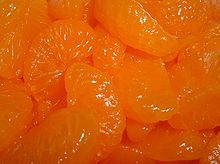- Mandarin orange
-
Mandarin orange 
Scientific classification Kingdom: Plantae (unranked): Angiosperms (unranked): Eudicots (unranked): Rosids Order: Sapindales Family: Rutaceae Genus: Citrus Species: C. reticulata Binomial name Citrus reticulata
BlancoThe Mandarin orange, also known as the mandarin or mandarine (both lower-case), is a small citrus tree (Citrus reticulata) with fruit resembling other oranges. Mandarin oranges are usually eaten plain or in fruit salads. Specifically reddish-orange mandarin cultivars can be marketed as tangerines, but this is not a botanical classification.
The tree is more drought-tolerant than the fruit. The mandarin is tender, and is damaged easily by cold. It can be grown in tropical and subtropical areas.
Contents
Varieties
The mandarin orange is but one variety of the orange family. The mandarin has many names, some of which actually refer to crosses between the mandarin and another citrus fruit.
- Satsuma, a seedless variety, of which there are over 200 cultivars, such as Owari and mikan; the source of most canned mandarins, and popular as a fresh fruit due to its ease of consumption
- Owari, a well-known Satsuma cultivar which ripens during the late fall season
- Clementine, sometimes known as a "Christmas orange", as its peak season is December; becoming the most important commercial Mandarin orange form, have displaced mikans in many markets
- Tangerine
- Tangor, also called the temple orange, a cross between the Mandarin orange and the common sweet orange; its thick rind is easy to peel and its bright orange pulp is sour-sweet and full-flavored
The mandarin is easily peeled with the fingers, starting at the thick rind covering the depression at the top of the fruit, and can be easily split into even segments without squirting juice. This makes it convenient to eat, as utensils are not required to peel or cut the fruit.
Canned mandarin segments are peeled to remove the white pith prior to canning; otherwise, they turn bitter. Segments are peeled using a chemical process. First, the segments are scalded in hot water to loosen the skin; then they are bathed in a lye solution which digests the albedo and membranes. Finally, the segments undergo several rinses in plain water.
During Chinese New Year, Mandarin oranges and tangerines are considered traditional symbols of abundance and good fortune. During the two-week celebration, they are frequently displayed as decoration and presented as gifts to friends, relatives, and business associates.
Biological characteristics
Citrus fruits are usually self-fertile (needing only a bee to move pollen within the same flower) or parthenocarpic (not needing pollination and therefore seedless, such as the satsuma).
Blossoms from the Dancy cultivar are one exception. They are self-sterile, and therefore must have a pollenizer variety to supply pollen, and a high bee population to make a good crop. The fruit is oblate.
Medicinal uses
In traditional Chinese medicine, the dried peel of the fruit is used in the regulation of ch'i, and also used to treat abdominal distension, to enhance digestion, and to reduce phlegm.[1][verification needed] Mandarins have also been used in ayurveda (traditional medicine of India).[2][verification needed]
Production volume
 Milgam hwachae, a Korean fruit dish made with mandarin oranges and honey
Milgam hwachae, a Korean fruit dish made with mandarin oranges and honey
Tangerines, mandarins, clementines
Top ten producers in 2007 (1000 tonnes) People's Republic of China
People's Republic of China15,185  Spain
Spain1,974  Brazil
Brazil1,206  Japan
Japan1,066  Morocco
Morocco1,042  South Korea
South Korea778  Egypt
Egypt748  Turkey
Turkey744  Iran
Iran702  Thailand
Thailand670  Pakistan
Pakistan640 All other 4,156 World total 27,869 Source:
UN Food & Agriculture Organisation (FAO), [1]The "Clemenules" (or "Nules", the Valencian town where it was bred) accounts for the great majority of clementines produced in the world. Spain alone has over 200,000 acres (800 km²), producing fruit between November and January. Mandarins marketed as tangerines are usually Dancy, Sunburst or Murcott (Honey) cultivars.
See also
- Fairchild tangerine
- Tangelo
- Naartjie
- Kinnow Mandarin
- Mandelo
References
- Notes
- "Citrus reticulata" at Plants for a Future
External links
- Mandarin Orange Nutrition Facts
- UC Riverside Mandarin Variety Descriptions
- Mandarin Orange - from Morton, J. (1987) Fruits of Warm Climates
- A Mandarin by Any Other Name by Cindy Fake, UC Davis Cooperative Extension[clarification needed]
Citrus Important species Citron • Key lime • Persian lime • Mandarin orange • Pomelo
Important cultivars Bitter orange • Clementine • Grapefruit • Lemon • Lime • Orange • Rangpur • Tangelo • Tangerine • Naartjie
Other topics Categories:- Citrus
- Fruits originating in Asia
- Vietnamese ingredients
Wikimedia Foundation. 2010.



